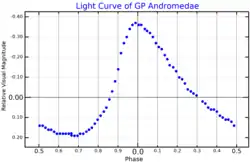 The visual band light curve of GP Andromedae, shown over one pulsation cycle, adapted from Szeidl et al.[1] | |
| Observation data Epoch J2000 Equinox J2000 | |
|---|---|
| Constellation | Andromeda |
| Right ascension | 00h 55m 18.1501s[2] |
| Declination | +23° 09′ 49.3715″[2] |
| Apparent magnitude (V) | 10.7 variable [3] |
| Characteristics | |
| Spectral type | A3[4] |
| Apparent magnitude (B) | 10.96[5] |
| Apparent magnitude (G) | 10.8282[2] |
| Apparent magnitude (J) | 10.071[6] |
| Apparent magnitude (H) | 10.018[6] |
| Apparent magnitude (K) | 9.993[6] |
| B−V color index | 0.164[5] |
| Variable type | Delta Scuti[4] |
| Astrometry | |
| Proper motion (μ) | RA: 25.77±3.38[2] mas/yr Dec.: −0.37±2.58[2] mas/yr |
| Parallax (π) | 1.9355 ± 0.1468 mas[2] |
| Distance | 1,700 ± 100 ly (520 ± 40 pc) |
| Details[7] | |
| Mass | 1.7±0.1 M☉ |
| Radius | 1.72[2] R☉ |
| Luminosity | 9.454[2] L☉ |
| Temperature | 7,718[2] K |
| Age | 13±3 Myr |
| Other designations | |
| Database references | |
| SIMBAD | data |
GP Andromedae (often abbreviated to GP And) is a Delta Scuti variable star in the constellation Andromeda.[4] It is a pulsating star, with its brightness varying with an amplitude of 0.55 magnitudes around a mean magnitude of 10.7.[3]
System
GP Andromedae is a main sequence Population I star of spectral type A3, placing it in the instability strip of the Hertzsprung-Russell diagram where Delta Scuti variables lay.[3]
A visual companion star 11 arcseconds away, named TYC 1739-1526-2, shares a common proper motion and has a similar distance (measured by parallax) as GP Andromedae.[8] There is no proof, however, that the two stars are gravitationally bound.[9]
Variability
The observed variability of GP Andromedae is typical for a Delta Scuti variable; it's a purely monoperiodic radial pulsating star with a period of 0.0787 days. The period of pulsations is slowly and continuously increasing, matching the predictions of stellar evolution models for Delta Scuti variables.[3]
References
- ↑ Szeidl, B.; Schnell, A.; Pocs, M. D. (July 2006). "The high-amplitude delta Scuti star GP Andromedae" (PDF). Information Bulletin on Variable Stars. 5718 (1): 1–4. Retrieved 9 October 2021.
- 1 2 3 4 5 6 7 8 9 Brown, A. G. A.; et al. (Gaia collaboration) (August 2018). "Gaia Data Release 2: Summary of the contents and survey properties". Astronomy & Astrophysics. 616. A1. arXiv:1804.09365. Bibcode:2018A&A...616A...1G. doi:10.1051/0004-6361/201833051. Gaia DR2 record for this source at VizieR.
- 1 2 3 4 Zhou, A. -Y.; Jiang, S. Y. (2011), "Period and Amplitude Variability of the High-amplitude δ Scuti Star GP Andromedae", The Astronomical Journal, 142 (4): 100, Bibcode:2011AJ....142..100Z, doi:10.1088/0004-6256/142/4/100.
- 1 2 3 GP And, database entry, Combined General Catalog of Variable Stars (GCVS4.2, 2004 Ed.), N. N. Samus, O. V. Durlevich, et al., CDS ID II/250 Accessed on line 2018-10-17.
- 1 2 Høg, E.; Fabricius, C.; Makarov, V. V.; Urban, S.; Corbin, T.; Wycoff, G.; Bastian, U.; Schwekendiek, P.; Wicenec, A. (2000), "The Tycho-2 catalogue of the 2.5 million brightest stars", Astronomy & Astrophysics, 355: L27–L30, Bibcode:2000A&A...355L..27H.
- 1 2 3 Cutri, Roc M.; Skrutskie, Michael F.; Van Dyk, Schuyler D.; Beichman, Charles A.; Carpenter, John M.; Chester, Thomas; Cambresy, Laurent; Evans, Tracey E.; Fowler, John W.; Gizis, John E.; Howard, Elizabeth V.; Huchra, John P.; Jarrett, Thomas H.; Kopan, Eugene L.; Kirkpatrick, J. Davy; Light, Robert M.; Marsh, Kenneth A.; McCallon, Howard L.; Schneider, Stephen E.; Stiening, Rae; Sykes, Matthew J.; Weinberg, Martin D.; Wheaton, William A.; Wheelock, Sherry L.; Zacarias, N. (2003). "VizieR Online Data Catalog: 2MASS All-Sky Catalog of Point Sources (Cutri+ 2003)". CDS/ADC Collection of Electronic Catalogues. 2246: II/246. Bibcode:2003yCat.2246....0C.
- ↑ Tetzlaff, N.; Neuhäuser, R.; Hohle, M. M. (2011), "A catalogue of young runaway Hipparcos stars within 3 kpc from the Sun", Monthly Notices of the Royal Astronomical Society, 410 (1): 190–200, arXiv:1007.4883, Bibcode:2011MNRAS.410..190T, doi:10.1111/j.1365-2966.2010.17434.x.
- ↑ "TYC 1739-1526-2". SIMBAD. Centre de données astronomiques de Strasbourg. Retrieved November 7, 2018.
- ↑ Liakos, A.; Nirchos, P. (2017), "Catalogue and properties of δ Scuti stars in binaries", Monthly Notices of the Royal Astronomical Society, 465 (1): 1181–1200, arXiv:1611.00200, Bibcode:2017MNRAS.465.1181L, doi:10.1093/mnras/stw2756, S2CID 119284575.